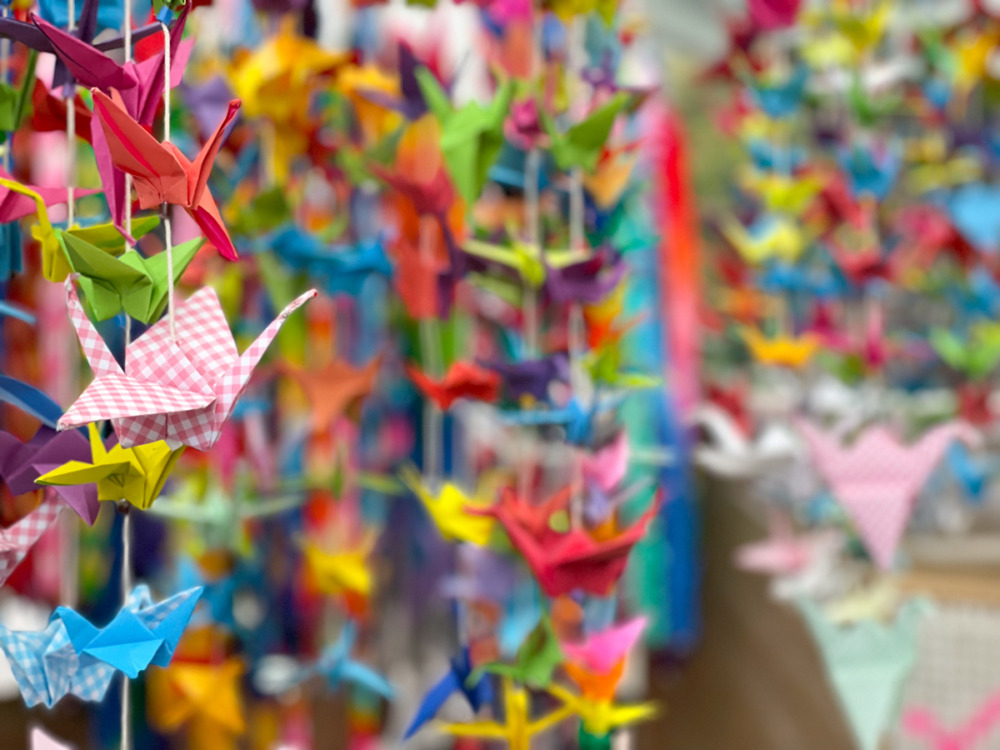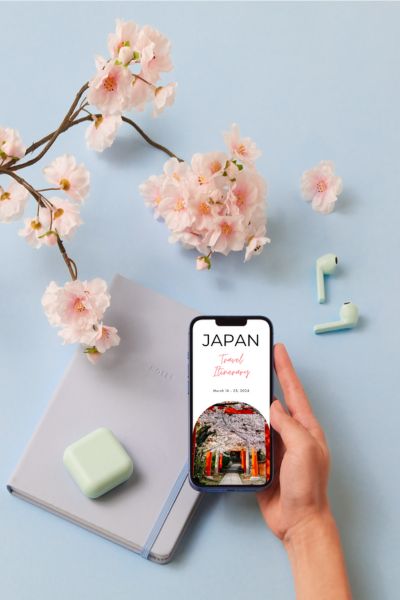Somber historical sites can prevent a real challenge to traveling families: you can’t fully experience a location without including them in your itinerary, but balancing the sensitivity and behavior of young children can be extremely difficult. In this article we address our experience visiting Hiroshima with kids to bear witness to the A-bomb sites.
After reading this article, you’ll be able to weigh the right way to handle this important site for your family including what aspects to see and what to omit (for at least certain members of your group).
Is it worth visiting Hiroshima with kids?
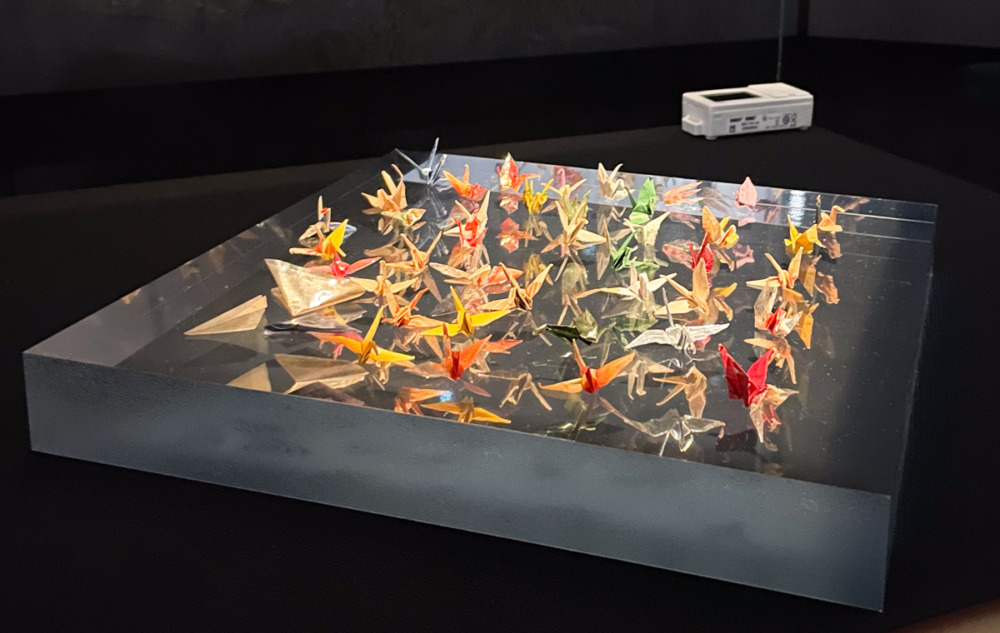
The destruction brought upon Japan toward the end of World War II had a drastic impact on the country’s direction for decades to follow. It’s hard to understate just how different the country is now than it was before the war, and how attitudes and infrastructure alike changed.
Many visitors to Japan feel compelled to visit Hiroshima either out of an interest in the history or a desire to pay their respects to a place where intense war later gave rise to enduring peace. Whatever your reason for considering a trip, if you’re visiting Japan with kids you’ll want to weigh whether or not they and the site are a good match.
First off, it’s good to know that Hiroshima Peace Memorial Park is made of multiple outdoor memorials along with a large museum. You can tailor your visit to your family’s needs and don’t need to feel obliged to see everything.
Second, even in the outdoor sites the tone is as somber as you would expect it to be. With the exception of the Children’s Peace Monument (more on that later), visitors are very quiet. You’ll want to consider whether or not your children can be respectful to the memories of those who died in Hiroshima as well as those coming to honor them.
Every family will need to weigh their unique circumstances to decide if it’s worth visiting Hiroshima with kids. It absolutely was for us, but our kids were 8.5 and 10.5 years old at the time.
Best books about Hiroshima for kids
You’ll spend your afternoon learning about the atomic bomb and its impact on the city and its people. How you do that will depend a lot on your kids’ ages and needs. We read several books with our kids in preparation for our visit and had plenty of discussions about why the bomb was dropped and how people were impacted.
First, What Was the Bombing of Hiroshima provides a lot of factual information and important context regarding World War II and the numerous factors that weighed into America’s decision to use the atomic bomb. This book is appropriate for kids who are ~7 years or older, and I strongly recommend that you read it together and pause often for your children to ask clarifying questions. There’s a lot of information, and many adults will find it educational as well!
Second, Sadako and the Thousand Paper Cranes offered the more human side to this challenging period in history. It shares the story of a young girl who dies of radiation poisoning a decade after the bomb was dropped. We also read the picture book version, Sadako, which is appropriate for younger readers.
Planning your day in Hiroshima with kids
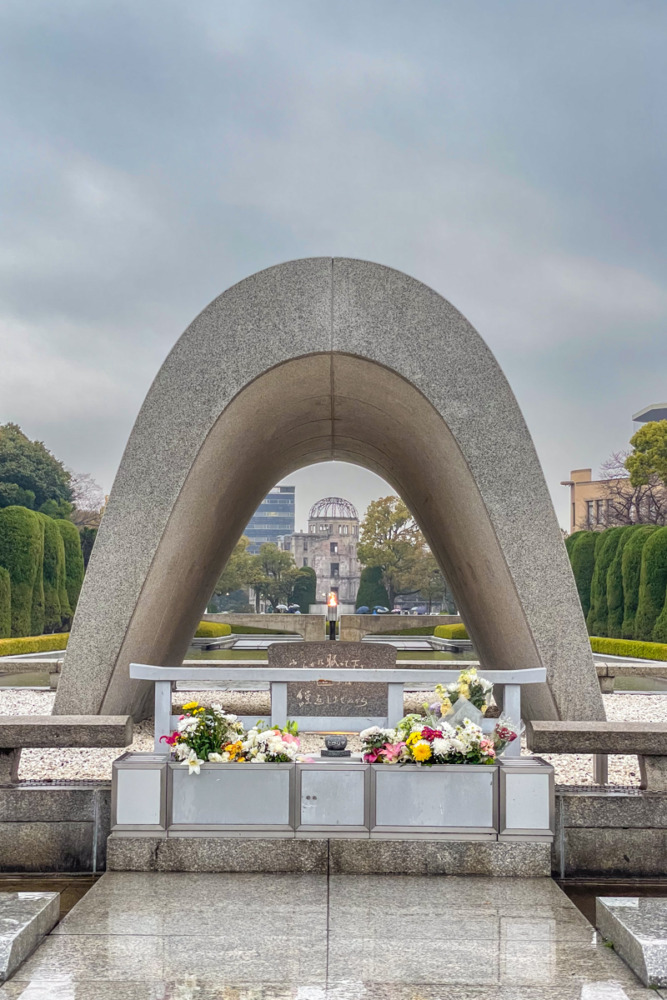
There are several sites within Peace Memorial Park that everyone should see. Before the war, the site was the beating heart of the city, with both commercial and government buildings. Just one of those still stands today, the battered shell of the Prefectural Industrial Promotion Hall – today known simply as the A-Bomb dome.
There are also two primary memorials with the park where all visitors should pay their respects: the arched Cenotaph for the Victims of the Atomic Bomb and the Children’s Peace Monument. The cenotaph stands over a list of the names of all those who died as a result of the bomb, from the initial blast to fallout-related diseases decades later. The Children’s Peace Monument is a statue of Sadako with one of her many paper cranes, and every year children from around the world send their own folded paper cranes to surround her.
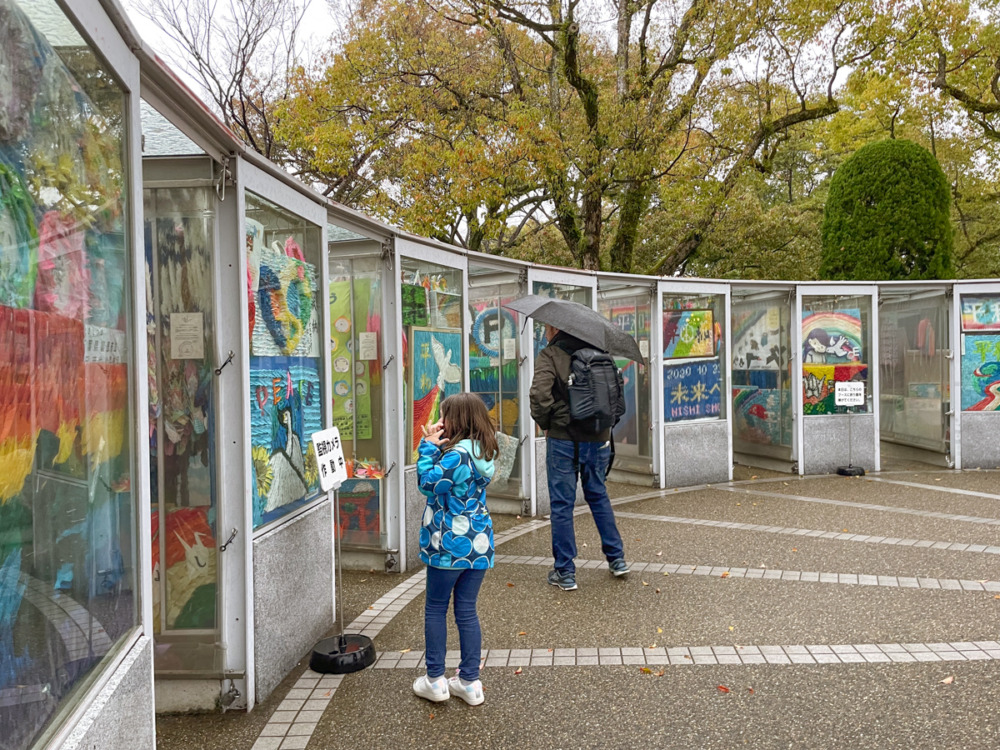
The largest site at Hiroshima Peace Memorial Park is the Hiroshima Peace Memorial Museum. I won’t mince words: this is a very difficult place to visit and you’ll have to weigh your children’s capacity for the graphic nature of the exhibits. We gave our children the choice of whether or not to visit and they both said they wanted to without hesitation.
We don’t shy away from hard topics and have taken our kids to both Pearl Harbor and the D-Day sites of Normandy, but the Peace Memorial Museum was much, much harder for them. Admission is free for children and just 200 JPY for adults and you don’t need to reserve admission, so you can take everyone’s temperature (so to speak) and make your decision on the fly. A thorough audio guide is included with admission.
The museum shows many photos of the city and its inhabitants after the bomb was dropped, but it’s also full of personal items that are even harder to see. There are mangled bicycles, children’s’ lunchboxes and the tattered uniforms of tweens who had been conscripted to work on the city’s fortifications in the immediate vicinity of the impact. Later on there are graphic photos of the impact of radiation poisoning even years later. I can’t emphasize enough how raw the core exhibit is.
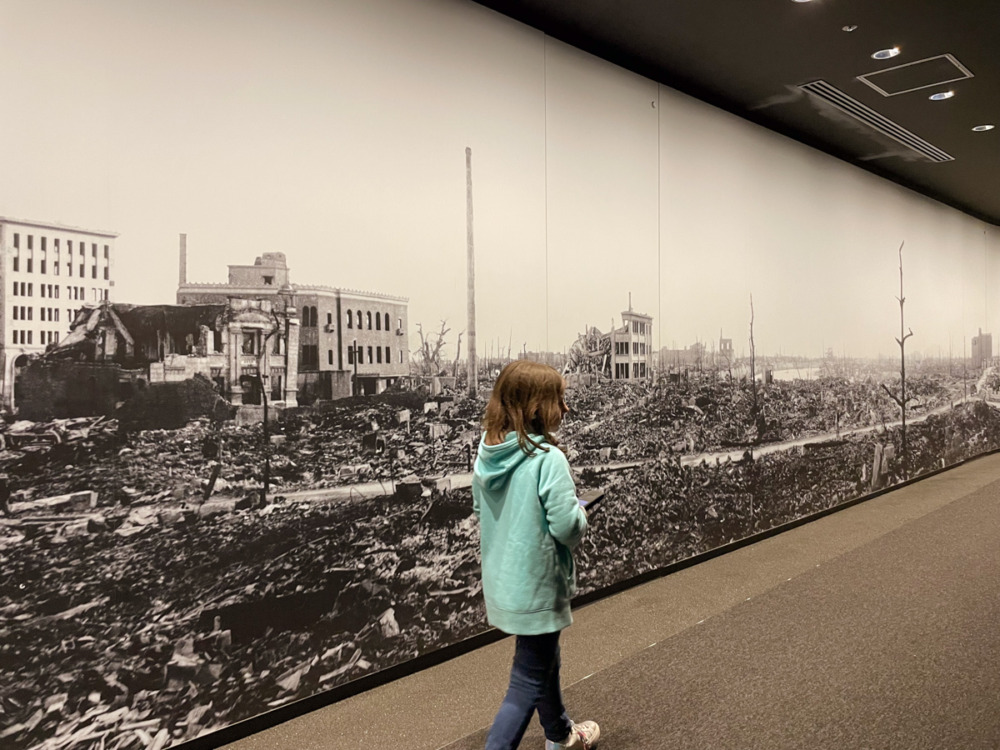
Our 8.5 year old came through the opening room of the museum’s core exhibit, which is a large scale projection of the city before and after the bomb. That was enough for her and she opted to stay on the benches outside of the main exhibit – a wise choice for her, and she spent that time re-reading Sadako and the Thousand Paper Cranes on one of our phones.
Our 10.5 year old felt it was important to bear witness and joined me in the main exhibit with his own audioguide. He made it about half-way through before deciding that he had seen enough and going to join his sister. Again, that was the right choice for him as he left right before some of the most devastating artifacts.
The main exhibit of the Hiroshima Peace Memorial Museum is not, in my opinion, a place to bring toddlers or boisterous children. It is a solemn, intense place and one adult near me even passed out in the middle of the exhibit.
If you have very young children and want to see the museum as an adult, I recommend doing a “parent swap” and you can each visit the Hiroshima History exhibit on the 2nd floor or head to the cafe on the outside of the building. That exhibit shows a small number of photos of the destruction but is much more focused on daily life before the bomb as well as the city’s rebuilding and subsequent emphasis on peace.
Are we glad we took our children to Hiroshima to see the A-bomb sites?
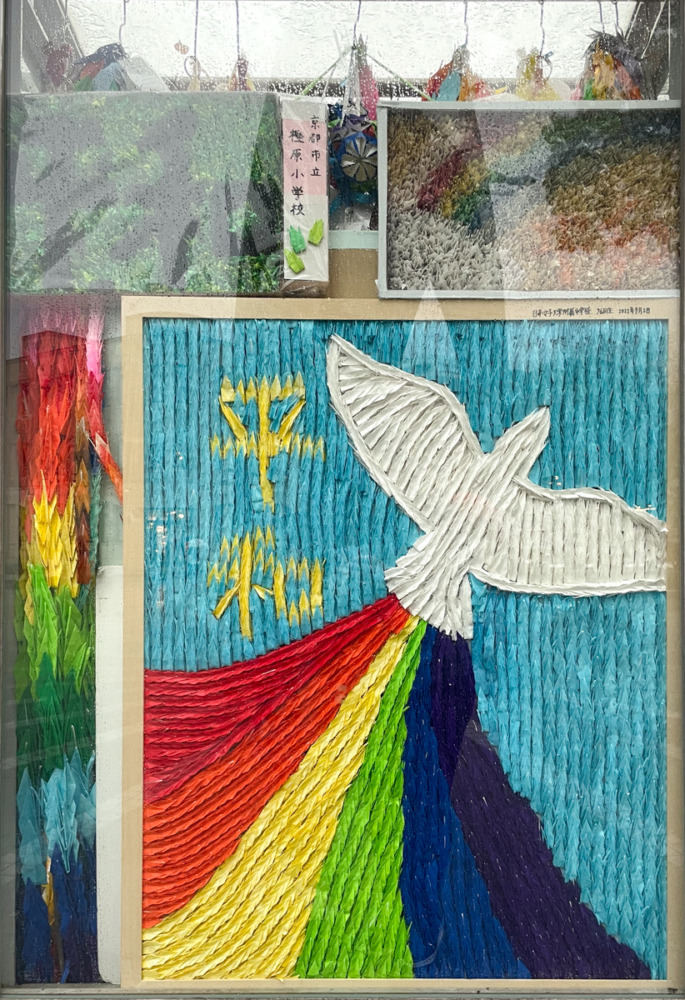
One of the best things about travel with kids is being able to really connect the things the hear and read about with the places where they occurred. While stopping in Hiroshima with kids felt very heavy compared to the rest of the light-hearted fun we had elsewhere in the country, we knew it was important to go.
Even though our kids only scratched the surface of what the Hiroshima Peace Memorial Museum offered, through our visits to the other parts of Peace Memorial Park and advance reading they understood the human and global importance of what happened there in a way that they otherwise wouldn’t have.
A visit to Hiroshima, no matter your age, is also an incredible reminder that from the ashes of war and destruction can rise a new hope for peace.
Want to organize your plans?
Grab our fully-customizable Japan digital travel planner!
Find out moreWhere to stay when you visit Hiroshima with kids
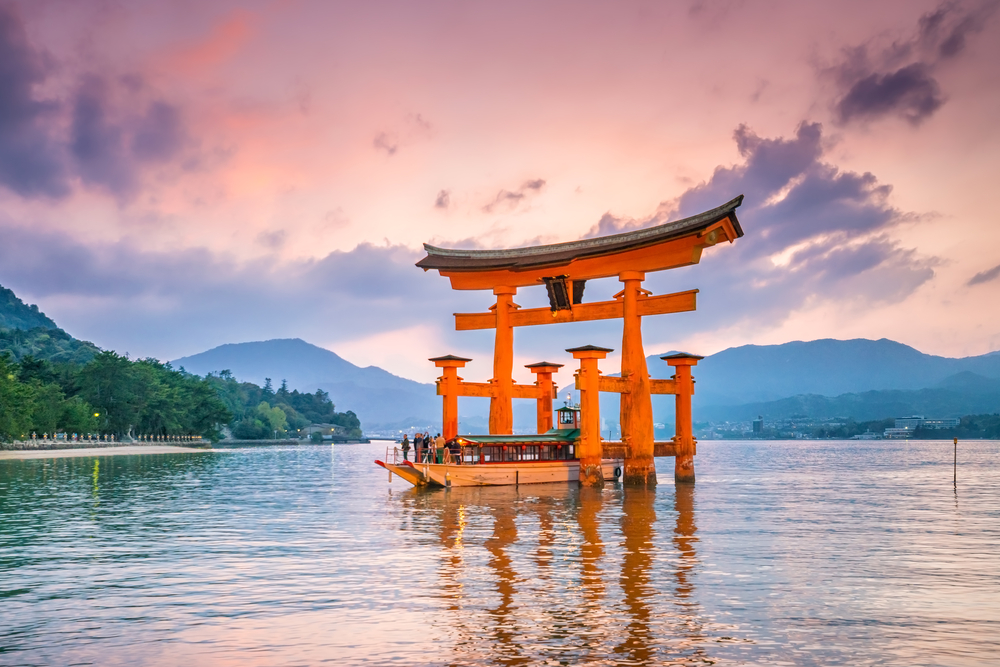
If you only have a typical 10-14 day trip to Japan with kids, you may not want to stay in Hiroshima itself. There are two good ways to incorporate it into your itinerary.
Stay on Miyajima Island
We chose to stay two nights on nearby Miyajima Island (pictured above). Despite its location in Hiroshima Bay, the island was barely impacted by the atomic bomb with just a little debris found nearby. Because it was undamaged, staying on Miyajima Island is like stepping back in time. It’s a popular location for day trippers, but overnight visitors will have the island to themselves after dark.
If you choose to stay on Miyajima, there’s a ferry service that leaves directly from Peace Memorial Park. We didn’t use it (because we didn’t know we should) but it’s by far the most convenient option.
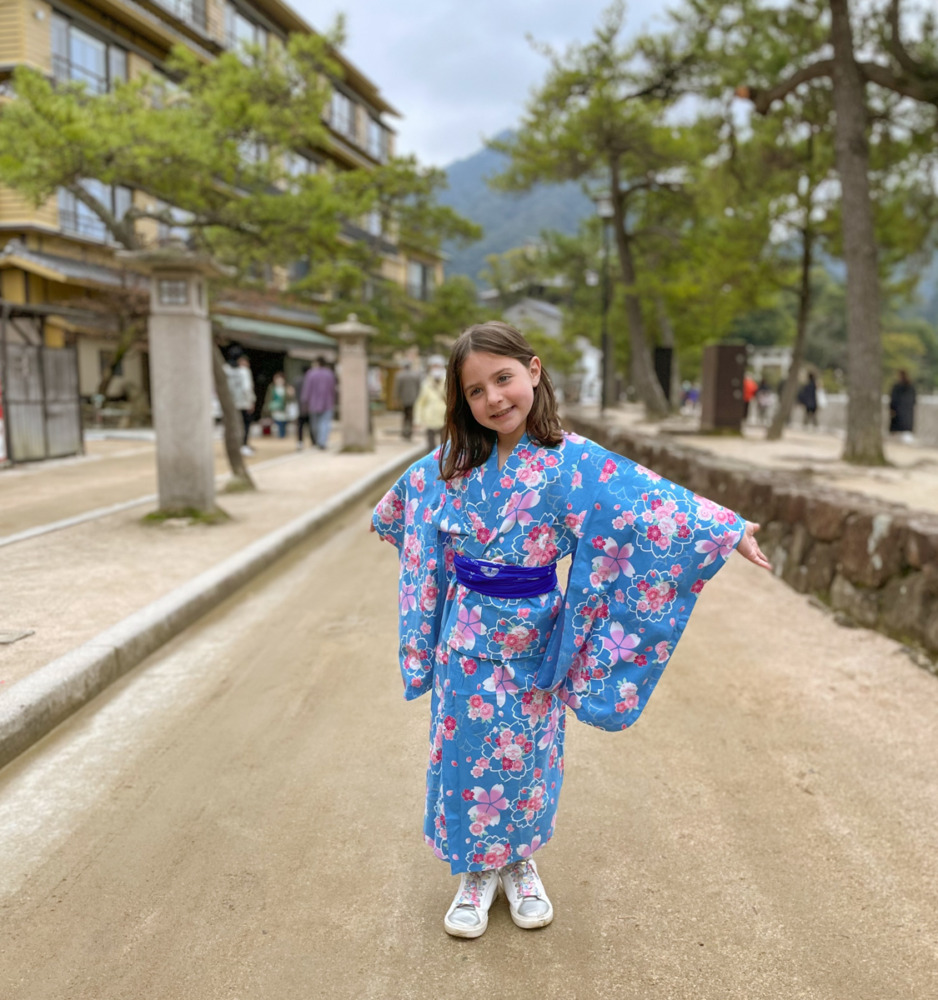
We stayed at Miyajima Kinsuikan, which is a quick walk from the ferry landing. It’s a very traditional ryokan, so this is a great opportunity to try traditional Japanese-style accommodations. Our room was set up each night with very comfortable futons and we had unlimited access to the onsen (hot spring public bath) in the basement. It was wonderful! Your room also comes with a seafood-heavy bento breakfast.
There are plenty of things to do on Miyajima Island the following day, and we especially enjoyed this tea ceremony and calligraphy class.
Day trip from Osaka or Kyoto
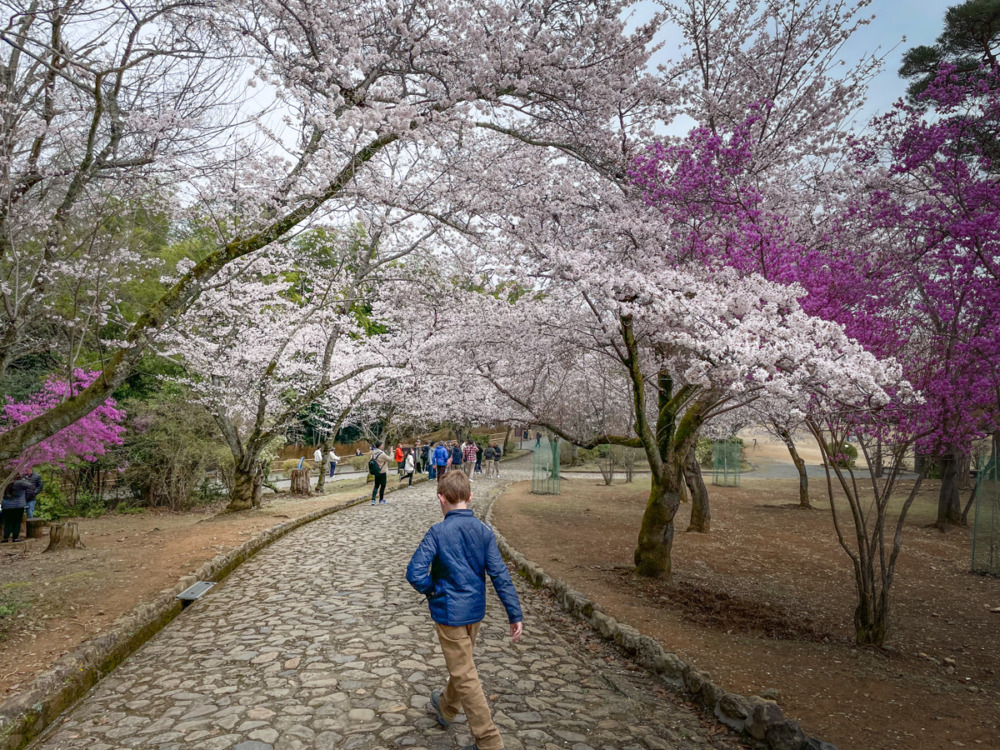
Another option for families who don’t want to unpack and repack as often is to visit Hiroshima on a day trip from Osaka or Kyoto in the Kansai region. Using your JR Pass, you can get from the main train station in Osaka to Hiroshima Peace Memorial Park in just about 2 hours.
If there’s an adult with you who isn’t interested in going to see the A-bomb sites in Hiroshima, you can consider having one adult take an organized day trip to Hiroshima – this one also visits Miyajima Island in the same day. The other adult can take the kid(s) to the wonderful aquarium in Osaka. Be sure to buy aquarium tickets in advance, as in-person tickets can have a multi-hour wait during busy times.
If you choose this option, consider staying at Mimaru Kyoto Station. It offers an incredibly convenient location, generous rooms for families and even the option of a Pokemon themed family apartment! We stayed in one of their other locations in Kyoto and it was excellent.
For families basing themselves in Osaka, Holiday Inn & Suites Shin Osaka is a great choice. You’ll find rooms that accommodate 4-5 people and even have laundry in their kitchenettes! You could also opt for the Hotel Intergate Osaka Umeda, which is more convenient for accessing both Osaka Castle and the aquarium.
Planning your family trip to Japan
I hope this guide to where to stay in Kyoto with a family has given you all of the information you need to plan an incredible visit to Kyoto with kids! Let me know in the comments if you have any more questions as you plan your own family trip.
Don’t miss these resources to plan your family trip to Japan:
- Buy your Japan Rail Pass
- Essential Japan Itinerary: 10 Days of Family-Friendly Travel
- What to Pack for Japan in Spring (and What to Leave at Home)
- Visiting Kyoto With Kids: 2+ Day Itinerary + Must-Read Travel Tips
- Best Family Hotels in Kyoto
- 9 Tips for Japan Travel You Can’t Afford To Miss
- Best Things to do in Japan With Kids: A Kid’s Take
- Things to do in Tokyo With Kids: Itinerary for 4 Days of Old and New
- The Best Hotels in Tokyo for Families (and How to Choose Yours)
- Awesome Pokémon Things to do in Japan
- 10 Japan Cultural Activities & Attractions For Your Bucket List
Still planning? Pin this for later!


